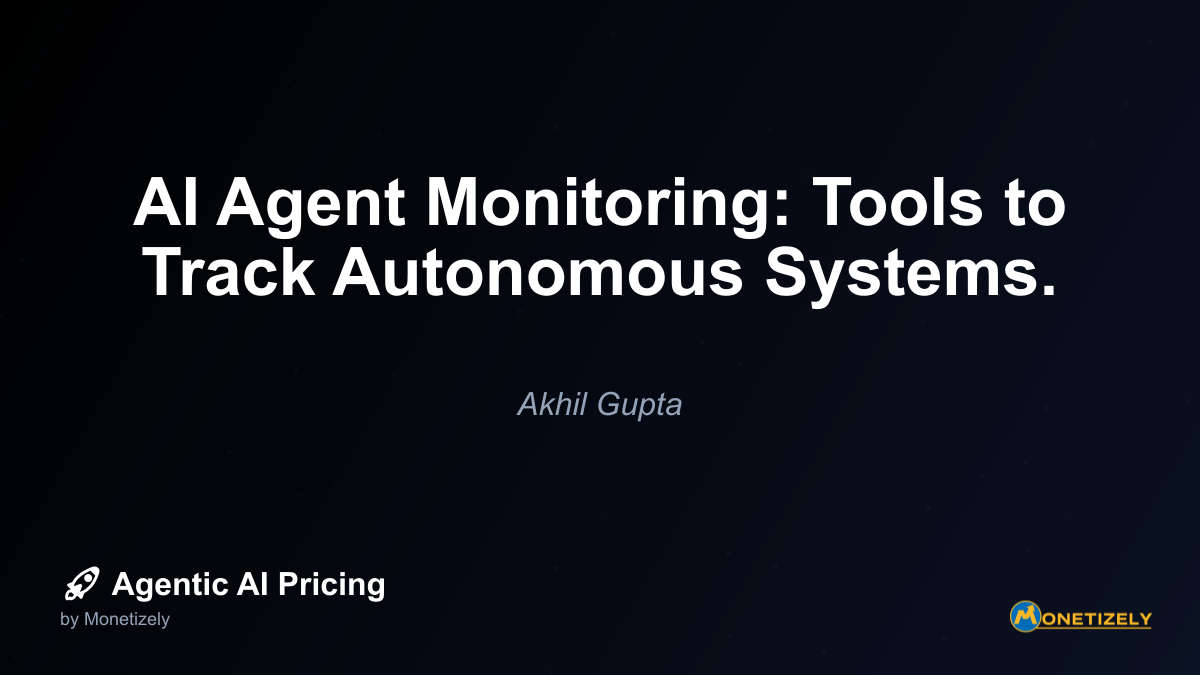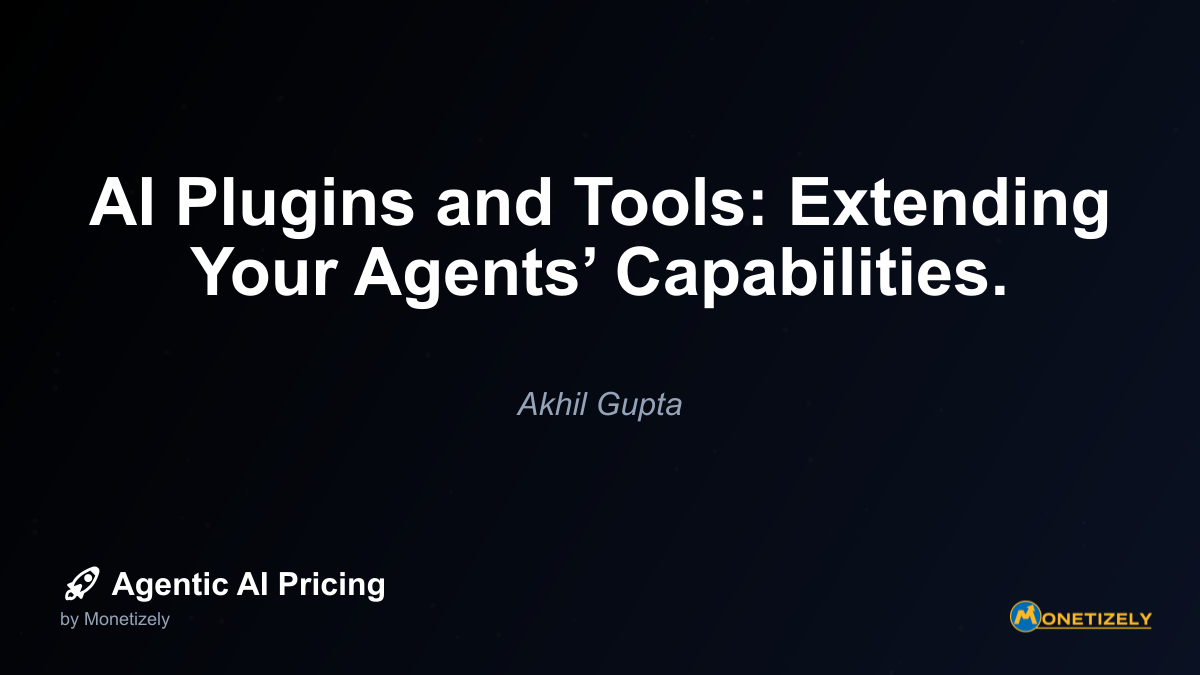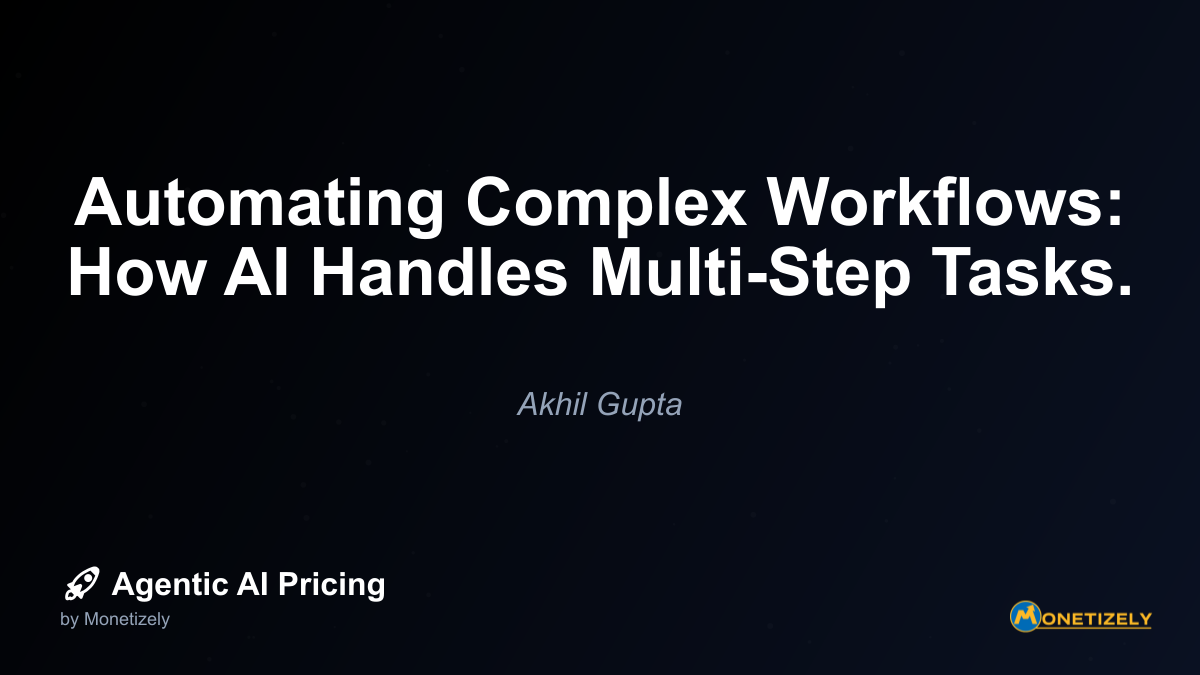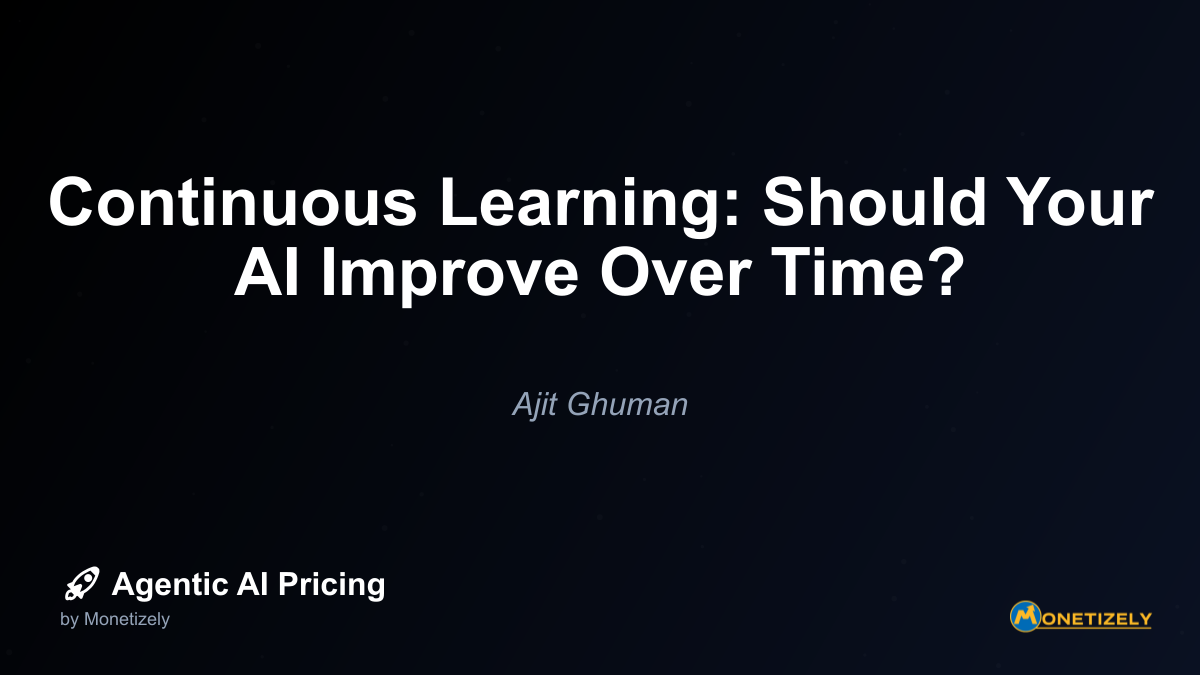· Ajit Ghuman · Technical Insights · 5 min read
Autonomy vs. Control: Setting Boundaries for AI Agents.
AI and SaaS Pricing Masterclass
Learn the art of strategic pricing directly from industry experts. Our comprehensive course provides frameworks and methodologies for optimizing your pricing strategy in the evolving AI landscape. Earn a professional certification that can be imported directly to your LinkedIn profile.
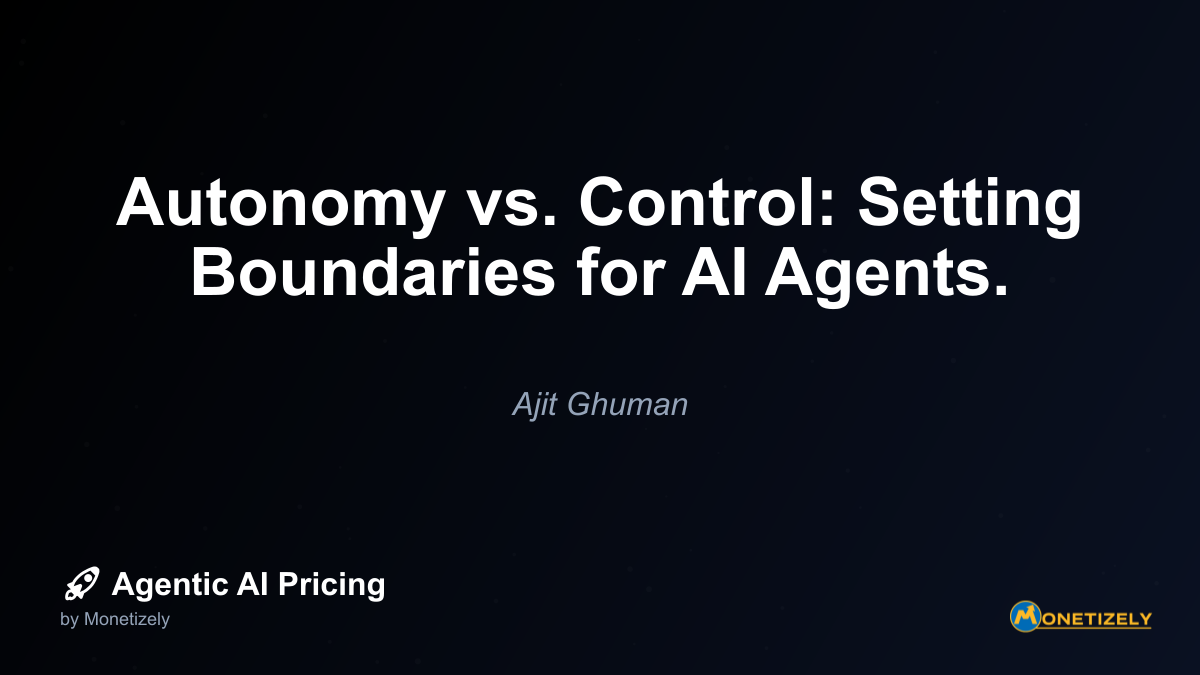
Designing Control Systems That Scale
As organizations expand their use of agentic AI, they face the challenge of scaling control mechanisms across multiple systems and use cases:
Centralized Governance Frameworks
Rather than implementing controls on a system-by-system basis, leading organizations are developing comprehensive governance frameworks:
- Unified permission management across AI systems
- Standardized approval workflows
- Centralized logging and monitoring
- Consistent human oversight protocols
Automated Control Systems
As AI deployments grow, manual oversight becomes increasingly challenging. Advanced organizations are implementing automated control systems:
- AI-powered monitoring of other AI systems
- Automated detection of anomalous behavior
- Dynamic adjustment of permission levels based on performance metrics
- Predictive risk assessment for AI actions
Cross-System Boundaries
Sophisticated control architectures consider how multiple AI systems interact:
- Permission inheritance across connected systems
- Coordinated approval workflows for multi-system actions
- Consistent control interfaces for human operators
- Shared learning from oversight decisions
As noted in our comprehensive guide on agentic AI governance, organizations that implement robust control frameworks early tend to scale their AI deployments more successfully and with fewer disruptions.
Balancing Control with Innovation
While establishing appropriate controls is essential, overly restrictive boundaries can undermine the value of agentic AI. Finding the right balance requires thoughtful consideration:
Progressive Autonomy Models
Rather than static control boundaries, consider implementing progressive autonomy frameworks:
- Initial Constrained Phase: Tight controls during initial deployment
- Supervised Expansion: Gradually expanded autonomy with close monitoring
- Earned Independence: Increased freedom in areas of demonstrated reliability
- Continuous Oversight: Maintained monitoring even in high-autonomy phases
Domain-Specific Control Calibration
Different business domains require different control approaches:
- Customer-Facing Functions: Typically require tighter controls due to brand risks
- Internal Operations: May allow greater autonomy, especially for routine tasks
- Creative Processes: Often benefit from looser constraints to enable innovation
- Regulated Activities: Demand strict controls with comprehensive audit trails
Control System Flexibility
Effective control frameworks adapt to changing conditions:
- Temporary elevation of restrictions during system updates
- Contextual relaxation of controls during time-sensitive operations
- Adaptive thresholds based on performance history
- Customized control profiles for different user roles
Measuring Control Effectiveness
How do you know if your control mechanisms are working? Establishing clear metrics helps organizations evaluate and refine their approach:
Safety Metrics
- Frequency of control interventions
- Severity of prevented incidents
- False positive rates for control triggers
- Detection time for anomalous behavior
Efficiency Metrics
- Processing delays caused by control mechanisms
- Human effort required for oversight activities
- Approval workflow completion times
- Exception handling efficiency
Balancing Metrics
- Autonomy-to-intervention ratio
- Control friction assessment
- User satisfaction with control interfaces
- Control system adaptation rate
One technology company developed a comprehensive “Control Effectiveness Index” that combines safety and efficiency metrics to track how well their control systems balanced protection with productivity.
Pricing Implications of Control Mechanisms
The autonomy-control balance has significant implications for AI pricing strategies:
Cost Structure Impact
More robust control mechanisms typically increase implementation and operational costs:
- Development of control interfaces
- Human oversight resources
- Monitoring and logging infrastructure
- Control system maintenance
Value Perception
Different customer segments perceive the value of controls differently:
- Enterprise clients often value robust controls and are willing to pay premium prices
- SMB customers may prefer simpler controls with lower price points
- Regulated industries require comprehensive controls regardless of cost implications
Pricing Model Alignment
Control mechanisms influence optimal pricing approaches:
- Usage-based pricing may need to account for control-related processing overhead
- Tiered pricing can offer different control levels at different price points
- Value-based pricing can quantify risk reduction provided by control features
Practical Implementation Strategies
Implementing effective control mechanisms requires a thoughtful approach:
Start with Risk Assessment
Before designing controls, conduct a comprehensive risk assessment:
- Identify potential failure modes for each AI agent
- Assess impact severity for each failure scenario
- Evaluate likelihood of different failure types
- Prioritize controls based on risk magnitude
Involve Multiple Stakeholders
Control design should incorporate diverse perspectives:
- Technical teams understand implementation feasibility
- Business users provide operational context
- Legal/compliance offers regulatory insight
- Security teams assess vulnerability implications
Implement Iteratively
Rather than attempting to build perfect controls initially:
- Start with essential controls for highest risks
- Test and refine with real-world usage
- Add additional controls based on observed needs
- Continuously evolve based on performance data
Document and Communicate
Clear documentation and communication are essential:
- Transparent explanation of control purposes
- Clear guidance for human reviewers
- Regular updates on control effectiveness
- Open channels for improvement suggestions
Future Trends in AI Control Systems
As agentic AI continues to evolve, we’re seeing emerging trends in control approaches:
Explainable Controls
Next-generation control systems provide clear explanations for why specific actions were flagged or restricted, helping users understand control decisions.
Collaborative Control Design
Advanced organizations are involving AI systems themselves in designing appropriate controls, leveraging their understanding of their own limitations.
Federated Control Systems
As AI ecosystems grow more complex, we’re seeing the emergence of federated control frameworks that coordinate oversight across organizational boundaries.
Adaptive Risk Models
The most sophisticated control systems now incorporate dynamic risk models that continuously update based on operational data and emerging threats.
Conclusion: Finding Your Organization’s Balance
There is no one-size-fits-all approach to balancing autonomy and control for AI agents. The optimal strategy depends on your organization’s risk tolerance, regulatory environment, technical capabilities, and business objectives.
However, the most successful implementations share common characteristics:
- Thoughtful design: Controls that address genuine risks without unnecessary restrictions
- User-centric implementation: Interfaces that make oversight efficient and intuitive
- Continuous evolution: Regular refinement based on performance data
- Balanced perspective: Recognition that both excessive and insufficient controls create risks
As you develop your organization’s approach to AI agent governance, remember that the goal isn’t maximum control or maximum autonomy—it’s finding the sweet spot that enables innovation while maintaining appropriate safeguards.
By implementing a thoughtful, layered approach to AI agent boundaries, organizations can harness the transformative potential of these systems while managing the associated risks. The future belongs to those who can navigate this balance effectively, creating AI systems that are both powerful and trustworthy.
Co-Founder & CEO
Ajit is the author of Price To Scale, a top book on SaaS Pricing and is the Founder of Monetizely. Ajit has led and worked in pricing and product marketing at firms like Twilio, Narvar and Medallia. His work has been featured in Forbes and VentureBeat. Ajit regularly consults with software companies from Seed stage to post-IPO on pricing strategy. Ajit is also a highly-rated co-instructor for 'The Art of SaaS Pricing and Monetization' on Maven.
Pricing Strategy Audit
Let our experts analyze your current pricing strategy and identify opportunities for improvement. Our data-driven assessment will help you unlock untapped revenue potential and optimize your AI pricing approach.

